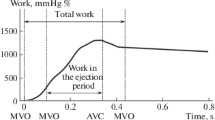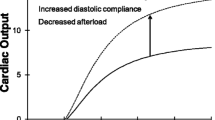Summary
We clarified that the set of the isotropic component (T) of wall tension and the area (A) of a selected region of the left ventricular wall expresses the regional work with sufficient accuracy. The area surrounded by the locus of theT-A relation in theT-A plane is approximately equal to the real work done by that region. The behavior of theT-A loop was studied in nine anesthetized dogs under various conditions. The regional area and diameter of the left ventricle were measured with ultrasonic crystal pairs. The wall tension was calculated from measured left ventricular pressure and diameter by a generalized Laplace's equation for a thick-walled model. During volume loading, administration of methoxamine, and aortic constriction, the regional work per stroke increased with the increase in end-diastolic regional area, which is considered to be the regional Frank-Starling mechanism. With the development of ischemia, theT-A loop for the ischemic region shifted to the right and the work done by that region decreased. After a certain stage in the development of ischemia, the work done by the ischemic region became negative. When only one of the segmental lengths, rather than the area, is measured, difficulty arises in the physical interpretation of pressure-length or tension-length data in some cases. TheT-A loop diagram resolves such difficulty by defining the regional work correctly. We conclude that theT-A loop diagram is a useful tool for analyzing the regional ventricular function.
Similar content being viewed by others
References
Maderia RG, de Rochemont WDM, Gadd CW, Stock TB, Bing RJ (1967) Measurement of the shortening of cardiac fibers in man. Am J Cardiol 19: 686–691
Herman MV, Gorlin R (1969) Implications of left ventricular asynergy. Am J Cardiol 23: 538–547
Fujita M, Sasayama S, Kawai C, Eiho S, Kuwahara M (1981) Automatic processing of cineventriculograms for analysis of regional myocardial function. Circulation 63: 1065–1074
Kerber RE, Marcus ML, Ehrhardt J, Wilson R, Abboud FM (1975) Correlation between echocardiographically demonstrated segmental dyskinesis and regional myocardial perfusion. Circulation 52: 1097–1104
Haendchen RV, Wyatt HL, Maurer G, Zwehl W, Bear M, Meerbaum S, Corday E (1983) Quantitation of regional cardiac function by two-dimensional echocardiography: I. Patterns of contraction in the normal left ventricle. Circulation 67: 1234–1245
LeWinter MM, Kent RS, Kroener JM, Carew TE, Covell JW (1975) Regional differences in myocardial performance in the left ventricle of the dog. Circ Res 37: 191–199
Theroux P, Ross J Jr, Franklin D, Kemper WS, Sasayama S (1976) Regional myocardial function in the conscious dog during acute coronary occlusion and responses to morphine, propranolol, nitroglycerin, and lidocaine. Circulation 53: 302–314
Edwards CH II, Rankin JS, McHale PA, Ling D, Anderson RW (1981) Effects of ischemia on left ventricular regional function in the conscious dog. Am J Physiol 240: H413-H420
Roan PG, Buja LM, Izquierdo C, Hashimi H, Saffer S, Willerson JT (1981) Interrelationships between regional left ventricular function, coronary blood flow, and myocellular necrosis during the initial 24 hours and 1 week after experimental coronary occlusion in awake, unsedated dogs. Circ Res 49: 31–40
Osakada G, Hess OM, Gallagher KP, Kemper WS, Ross J Jr (1983) End-systolic dimension-wall thickness relations during myocardial ischemia in conscious dogs: A new approach for defining regional function. Am J Cardiol 51: 1750–1758
Geffin GA, Drop LJ, O'Keefe DD, Rosenthal SV, Newell JB, Jacocks MA, Daggett WM (1983) Global and regional function in the regionally ischaemic left ventricle related to plasma ionised calcium. Cardiovasc Res 17: 415–426
Kaseda S, Tomoike H, Ogata I, Nakamura M (1984) End-systolic pressure-length relations during changes in regional contractile state. Am J Physiol 247: H768-H774
Fung YC (1965) Foundations of solid mechanics. Prentice-Hall, Englewood Cliffs
Huisman RM, Sipkema P, Westerhof N, Elzinga G (1980) Comparison of models used to calculate left ventricular wall force. Med Biol Eng Comput 18: 133–144
Yin FCP (1981) Ventricular wall stress. Circ Res 49: 829–842
Suga H, Goto Y, Yamada O, Igarashi Y (1984) Is regional ventricular wall work determined from regional force and shortening always consistent with the law of conservation of energy? Jpn Circ J 48: 1007–1016
Falsetti HL, Mates RE, Grand C, Greene DG, Bunnell IL (1970) Left ventricular wall stress calculated from one-plane cineangiography: An approach to force-velocity analysis in man. Circ Res 26: 71–83
Arts T, Veenstra PC, Reneman RS (1982) Epicardial deformation and left ventricular wall mechanics during ejection in the dog. Am J Physiol 243: H379–390
Feigl EO, Fry DL (1964) Intramural myocardial shear during the cardiac cycle. Circ Res 14: 536–540
Fenton TR, Cherry JM, Klassen GA (1978) Transmural myocardial deformation in the canine left ventricular wall. Am J Physiol 235: H523-H530
Osakada G, Sasayama S, Kawai C, Hirakawa A, Kemper WS, Franklin D, Ross J Jr (1980) The analysis of left ventricular wall thickness and shear by an ultrasonic triangulation technique in the dog. Circ Res 47: 173–181
Gould KL, Lipscomb K, Hamilton GW, Kennedy JW (1974) Relation of left ventricular shape, function and wall stress in man. Am J Cardiol 34: 627–634
Sarnoff SJ, Berglund E (1954) Ventricular function: I. Starling's law of the heart studied by means of simultaneous right and left ventricular function curves in the dog. Circulation 9: 706–718
Timoshenko SP, Woinowsky-Krieger S (1970) Theory of plates and shells, ed 2. McGraw-Hill Kogakusha, Tokyo, pp 429–435
Schlichting H (1968) Boundary-layer theory, ed 6, translated by J Kestin. McGraw-Hill, New York, pp 44–64
Author information
Authors and Affiliations
Rights and permissions
About this article
Cite this article
Sugawara, M., Tamiya, K. & Nakano, K. Regional work of the ventricle: Wall tension — area relation. Heart Vessels 1, 133–144 (1985). https://doi.org/10.1007/BF02066408
Issue Date:
DOI: https://doi.org/10.1007/BF02066408




